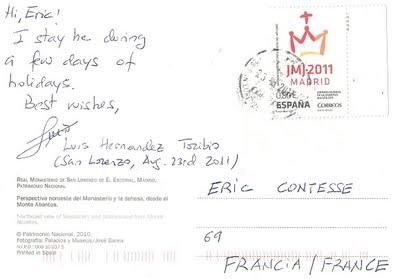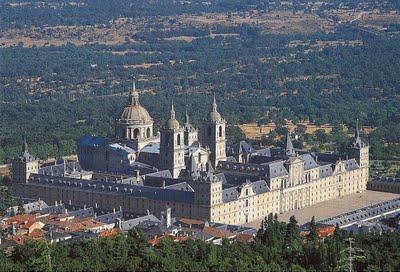C'est au pape Jean-Paul II que l'on doit, à partir de 1984, cette idée de rassembler régulièrement les jeunes catholiques du monde entier, afin de stimuler leur participation au sein de l'église...
La journée mondiale de la jeunesse (JMJ) est ainsi célébrée chaque année dans tous les diocèses (le dimanche des rameaux) et, tous les 2 ou 3 ans, un grand rassemblement international a lieu en présence du pape.
Benoit XVI a ainsi accueilli cette année les jeunes catholiques à Madrid à l'occasion de la 26ème édition des JMJ organisées du 16 au 21 août 2011, avec pour thème "Enracinés et fondés en Christ, affermis dans la foi" (Lettre de St Paul aux chrétiens de Colosse - Chapitre 2 Verset 7).
It's the Pope John Paul II who, in 1984, had this idea of regular meetings between young Catholics from around the world to stimulate their participation in the Church...
The World Youth Day (WYD) is thus celebrated every year in all the dioceses (on Palm Sunday) and, every 2 or 3 years, a large international gathering is organized in the presence of the pope.
Benedict XVI has thus welcomed the young Catholics this year in Madrid at the occasion of the 26th World Youth Day held from 16 to 21 August 2011, with the theme "Planted and built up in Jesus Christ, firm in the faith" (Letter of St. Paul to the Christians of Colossae - Chapter 2 Verse 7).
 Après Saint-Jacques-de-Compostelle en 1989, c'était ainsi la 2ème fois que l'Espagne organisait cet manifestation internationale qui a réuni près de 2 millions de jeunes.
Après Saint-Jacques-de-Compostelle en 1989, c'était ainsi la 2ème fois que l'Espagne organisait cet manifestation internationale qui a réuni près de 2 millions de jeunes.
Les administrations postales d'Espagne et de la Cité du Vatican ont émis pour l'occasion un timbre commun reproduisant le logo officiel de ces 26èmes JMJ.
C'est ce timbre espagnol (0,80€), émis le 1er juillet 2011, qui figure sur la carte ci-dessus postée le 23 août 2011 de San Lorenzo de El Escorial.
Merci beaucoup Luis :-)
A noter qu'il ne s'agit pas vraiment d'une émission commune puisque le timbre du Vatican (0,75€) a été émis le 21 juin 2011...
Le logo ci-dessus, conçu par le graphiste José Gil-Nogués, est une allégorie de l'union des jeunes du monde entier au pied de la croix, l'ensemble formant la couronne de la Vierge de l'Almudena, sainte patronne de Madrid. La couronne évoque ainsi à la fois le "M" de Marie et la ville de Madrid.
Rendez-vous en 2013 à Rio de Janeiro pour les 28èmes JMJ !
After Santiago de Compostela in 1989, it was thus the 2nd time that Spain organized this international event which has brought together nearly 2 million young people.
The postal administrations of Spain and Vatican City have issued a joint stamp for the occasion, reproducing the official logo of this 26th World Youth Day.
It's the Spanish stamp (€ 0.80), issued on July 1, 2011, that appears on the postcard above mailed on August 23, 2011 from San Lorenzo de El Escorial.
Thank you very much Luis :-)
To note that this is not really a joint stamp issue as the Vatican's stamp (€ 0.75) was issued on June 21, 2011...
The logo above, designed by graphic artist José Gil-Nogués, is an allegory of the union of young people worldwide at the foot of the cross, the whole forming the crown of the Virgin of the Almudena, patron saint of Madrid. The crown evokes thus both the "M" of Mary and of the city of Madrid.
See you in 2013 in Rio de Janeiro, Brazil for the 28th World Youth Day !
 L'autre face de cette carte ci-dessus montre une splendide vue du monastère royal et site de San Lorenzo de El Escorial, depuis le mont Abantos.
L'autre face de cette carte ci-dessus montre une splendide vue du monastère royal et site de San Lorenzo de El Escorial, depuis le mont Abantos.
Ce complexe (monastère, musée, palais, bibliothèque, Panthéon des rois, ancienne résidence du roi d'Espagne) d'une exceptionnelle beauté, construit à la fin du 16ème siècle par Philippe II et situé à 45 km au nord-ouest de Madrid, a été inscrit sur la liste du patrimoine mondial de l'UNESCO en 1984.
The other side of this card above shows a splendid view of the royal monastery and site of San Lorenzo de El Escorial, from Mount Abantos.
This exceptionally beautiful complex (monastery, museum, palace, library, Pantheon of the Kings, the former residence of the king of Spain), built at the end of the 16th century by Philip II and located 45 km northwest of Madrid, was listed as UNESCO World Heritage site in 1984.

